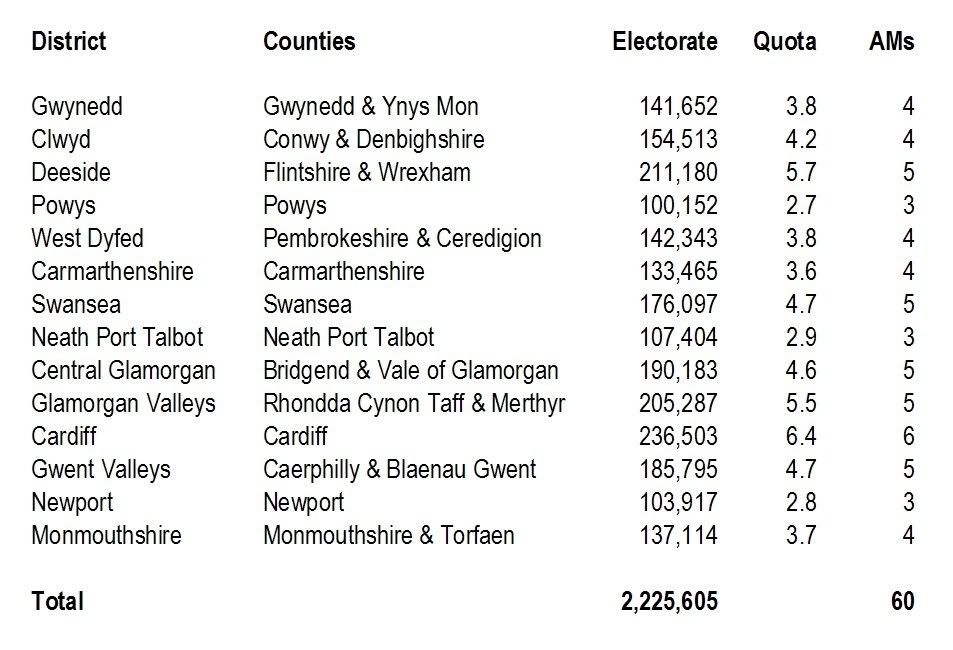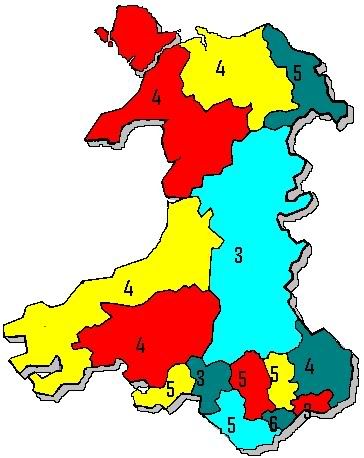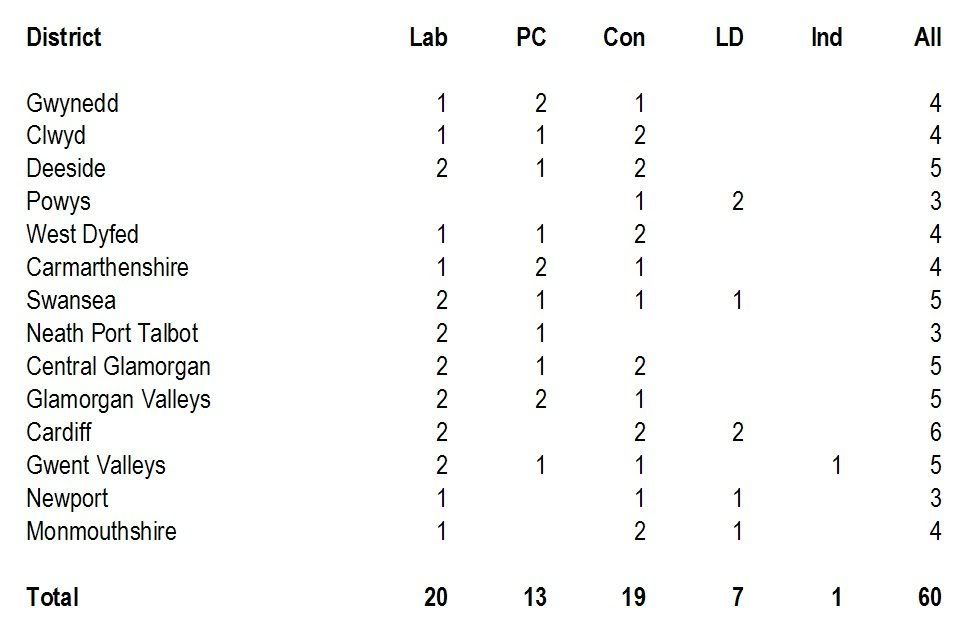A guest post by Penddu
I have been giving some thought as to what the Assembly elections might look like if they were conducted using STV with multi-member constituencies or Districts. Using the figures from the Boundary Commission for Wales latest (2003) reports, Wales has an electorate of 2,225,605 which, assuming the existing total of 60 AMs, means that each AM would need to represent 37,093 voters.
Rather than base new Districts on existing constituencies, I have used the Counties as a basis, as the public usually has a clearer affinity to these. I have aimed to create 4 member or 5 member districts representing a total electorate of 148,373 or 185,547 respectively. But I have also created a number of smaller 3 member districts and one 6 member distict where these seem to be more obvious. A first rough pass gives:
This map shows the initial boundaries, but these would need further local adjustments so as to even up the sizes of the constituencies.
But how would the parties be distributed within each seat?
Taking Cardiff as an example, the combined votes in the 2007 Assembly election would give:
Labour ... 35,802
Conservative ... 32,414
Liberal Democrat ... 25,282
Plaid Cymru ... 13,890
UKIP ... 2,308Total ... 107,388
The first step is to calculate the qualifying quota - calculated by dividing the total number of votes by the number of seats plus 1 - giving:
Quota = (107,388/(6+1))+1 = 15,342
For every 15,342 votes as first preference, each party would win 1 seat, with remaining unused votes counted:
Labour ... 2 Seats ... remainder 5,118 votes
Conservative ... 2 Seats ... remainder 1,730 votes
Liberal Democrat ... 1 Seat ... remainder 9,940 votes
Plaid Cymru ... No Seats ... remainder 13,890 votes
UKIP ... No Seats ... remainder 2,308 votes
The remaining smallest party is then eliminated and its votes reallocated to the stated second preference party and added to the remaining unused votes, until a party can achieve a quota. In this case, UKIP would be eliminated and its votes distibuted to the stated second preferences. Plaid would need to pick up 1,452 votes to win the 6th seat, otherwise they would be eliminated and their votes redistributed. In this case it would probably give the Liberal Democrats the final seat but with STV encouraging smaller parties like the Greens to enter candidates, and people more likley to vote for their first choice party without fear of it being a wasted vote, the voting patterns become far more tactical, and difficult to predict.
Overall I predict that if the 2007 elections had been based on STV, then seats would "probably" have been distributed:
I have had to make some assumptions about second and third preference votes to get to these figures and, more importantly, electors may vote differently if there is more chance of their vote being counted. Neither am I suggesting that this would be the result if the election was held today.





7 comments:
I think this is a great piece of work. Well done, Pen.
My only, slight, difference would be that I would prefer each constituency to aim for about 6 seats, rather than 4 or 5. However, if we were to reach a situation where the Senedd had 80AMs, it would mean that these same 14 districts would on average each have an extra seat, sometimes two. And that, for me, would be just about as good as it gets.
Well done - it's an excellent piece of work.
I would add though that STV throws up unexpected results all the time - & succeeding at it requires a party to be bang on when it comes to tactics. Geographic balance between candidates, a deliberate strategy to try to get your candidates to get as even a share of your party's votes as possible & in some circimstances the selection of a so called 'sweeper' candidate are examples.
It's common for candidates to get close to a quota on the first vote, but fail to get elected - & it's common for a candidate to get elected after only achieving a fraction of a quota.
STV is more propotional than FPTP on a national level, but on a constituency level it can be highly unpredictable.
How proportianal is they? The tories have only one seat leas than labour, surely the results werent that close?, also wasnt there a much narrower gap between the Tories and PC
In STV the result is also far more reliant on the popularity of individual candidates.
Personally I prefer the open list system, by which people vote for a party (or an independent) and each party (or independent) gets allocatd a number of seats, much as in the EP elections. the difference is that the list of candidates standing for each party is not fixed, and the voters have a chance to rank them 1st, 2nd etc so that when the seats are allocated these votes then decide which candidate is elected.
Thanks for the feedback - it was only intended to be a bit of idle timewasting so my apologies if it could have been more accurate....
But it got me thinking about how oure elected representatives would actually do their job - take my West Dyfed district - Would our representatives carve up the district bewtween them - say Plaid focus on Ceredigion, Labour on Pembroke & Milford Haven, and the 2 Conservatives on north and south Pembrokeshire - so as to maximise their votes next time around - might they even agree to do so - and maybe it is not a bad idea???
The writers appear to have formulated their conclusions without knowledge of the submission made in 2003 by the Parliament for Wales Campaign to the Richard Commission – which came to essentially identical conclusions.
It is reasonable to infer that these independent analyses, having come to such similar conclusions, are robust and do hold out the prospect of genuine proportionality for STV in an 80-seat Senedd.
However, the most telling arguments for STV is that it combines proportionality with a genuinely greater voter choice. The full submission can be read on www.richardcommission.gov.uk/content/evidence/responses/coxj/index-e.pdf and the text of the discussion that ensued on http://www.richardcommission.gov.uk/content/template.asp?ID=/content/evidence/oral/pow/index-e.asp
Thanks for the links to PfW, Anon.
I thought it was worth highlightling them in a new post.
I've always thought the best solution would be to join each of the 40 Assembly constituencies into groups of two, then give each seat 4 AMs to accommodate for a Senedd of 80 members, elected via STV.
Post a Comment